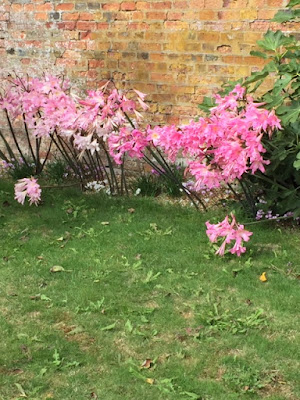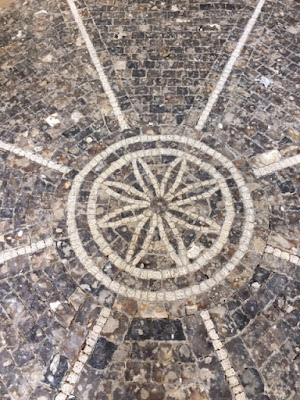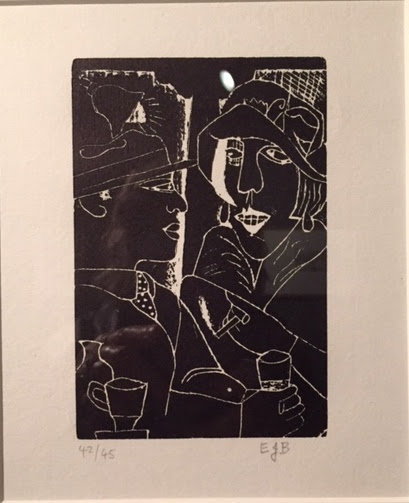This was my first visit of the year to the fabulous West Dean Gardens, in the interval since my last visit, Head Gardeners Sarah Wain and Jim Buckland had retired after 28 years of running the gardens. Tom Brown took over as head gardener, I think before lockdown, after 10 years at RHS Wisley and another 10 years at Parham House. It may be that he has had to operate without the help of the 50 volunteers who normally help keep the gardens and glasshouses in tip top condition alongside the 6 gardeners and Tom. Searching the blog, I find there are 2 previous posts on West Dean: here summer 2018 and here this January.
As was expected, there are differences this year, firstly you have to buy tickets in advance of arrival to avoid too many people arriving at once. We had lunch there and found that the cafe is very well managed, we ate outside, and were very pleased with the speedy arrival of the delicious prawn and avocado sandwiches.
The walled garden was looking good, especially the cut flower part where there were Salvias, Asters and Dahlias were flowering in riotous profusion:
Double Dahlias above and single below, there were labels for everything, but I didn't photograph the labels this time. I do love to know what everything is, but apart from checking they had one of my favourite Salvias-Phyllis Fancy, I didn't look much at labels this timeA view of the Dahlias below, you can see the big white labels
This was a lovely combination, Aster, Verbena and Pennisetum
Aren't these gorgeous?
And on our way out of the walled garden, these Actea caught my attention, don't they look good in a clump?
I think because of lack of volunteers, the glasshouses were closed, normally they are for me one of the highlights of the garden. I'll find a link to a previous visit and show you what I mean.
There were some delightfully placed Nerines in one of the glasshouses, on looking at the West Dean website, I saw these were Amarines, a cross between Amaryllis and Nerines apparently.There were also some outside against the brick wall of the garden:
From the walled garden, we walked out into the rest of the garden, along by the river
The Hydrangeas looked fantastic, growing in partial shade beneath trees, are these Limelight I wonder?The Sedums also looked wonderful
From there we walked along the 100m long pergola designed by Harold Peto, it's always a lovely place to walk down, and get some great photos:
There's a small sitting area at one end, with horse's teeth making the floor!I walked half way down, and looked one way
and then back the other way
We had quite a tight itinerary that day, visiting the Pallant House Gallery in the afternoon, again we were booked into a slot in the afternoon. Great consideration had been given to social distancing in the gallery. In the Print Room there was an exhibition of works inspired by Gilbert White's book 'Drawn to Nature' which made an excellent present for Lyn, there was a limit of six people allowed in there. The rest of the galleries are larger, so people were expected to keep 2 metres apart. It felt really special to be able to see an exhibition. The main one being Barnett Freedman: Designs for Modern Britain, although a contemporary of Eric Ravilious, Edward Burra, Edward Bawden and Enid Marx, I don't think Barnett Freedman is as well known, although his image of a darts player is very familiar. More on Barnett Freedman, including information about his Guiness prints and the silver jubilee stamp produced in 1935 here.
Also running alongside the exhibition is another one: An Outbreak of Talent: Bawden, Marx, Ravilious and their contemporaries which is also fabulous. These two were particular favourites of mine:
The one above, entitled 'Untitled' (Two Ladies) is a woodcut on paperand this one is a linocut on paper from 1958 by Enid Marx, with the following information about her:
While a student at the Royal College of Art in the early 1920s, Nash recognized her originality as a pattern maker and encouraged her to become an early member of the Society of Wood Engravers and the Society of Artists. After working as an apprentice, she set up her own workshop in Hampstead, specializing in hand-block printed textiles. Following the success of her design for the seating of London Transport, Marx worked for the wartime Utility Scheme set up by the British Board of Trade and was made a Royal Designer for Industry in 1945.
What a brilliant day out, great to have a look at exhibitions at the Pallant House Gallery and look round West Dean Gardens.

















Comments
Post a Comment